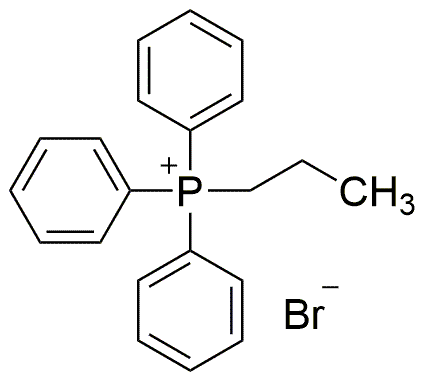Propyltriphenylphosphonium bromide is widely utilized in research focused on:
- Synthesis of Organophosphorus Compounds: This compound serves as a key reagent in the synthesis of various organophosphorus compounds, which are important in pharmaceuticals and agrochemicals.
- Biological Studies: It is used in biological research to investigate cell membrane dynamics and transport mechanisms due to its ability to penetrate lipid membranes.
- Catalysis: This chemical acts as a catalyst in organic reactions, enhancing reaction rates and selectivity, making it valuable in the development of new materials and chemicals.
- Fluorescent Probes: It is employed in the creation of fluorescent probes for imaging applications in cellular biology, allowing researchers to visualize cellular processes.
- Electrochemical Applications: The compound is used in electrochemistry for the development of sensors, providing high sensitivity and specificity for detecting various analytes.
General Information
Properties
Safety and Regulations
Applications
Propyltriphenylphosphonium bromide is widely utilized in research focused on:
- Synthesis of Organophosphorus Compounds: This compound serves as a key reagent in the synthesis of various organophosphorus compounds, which are important in pharmaceuticals and agrochemicals.
- Biological Studies: It is used in biological research to investigate cell membrane dynamics and transport mechanisms due to its ability to penetrate lipid membranes.
- Catalysis: This chemical acts as a catalyst in organic reactions, enhancing reaction rates and selectivity, making it valuable in the development of new materials and chemicals.
- Fluorescent Probes: It is employed in the creation of fluorescent probes for imaging applications in cellular biology, allowing researchers to visualize cellular processes.
- Electrochemical Applications: The compound is used in electrochemistry for the development of sensors, providing high sensitivity and specificity for detecting various analytes.
Documents
Safety Data Sheets (SDS)
The SDS provides comprehensive safety information on handling, storage, and disposal of the product.
Product Specification (PS)
The PS provides a comprehensive breakdown of the product’s properties, including chemical composition, physical state, purity, and storage requirements. It also details acceptable quality ranges and the product's intended applications.
Certificates of Analysis (COA)
Search for Certificates of Analysis (COA) by entering the products Lot Number. Lot and Batch Numbers can be found on a product’s label following the words ‘Lot’ or ‘Batch’.
*Catalog Number
*Lot Number
Certificates Of Origin (COO)
This COO confirms the country where the product was manufactured, and also details the materials and components used in it and whether it is derived from natural, synthetic, or other specific sources. This certificate may be required for customs, trade, and regulatory compliance.
*Catalog Number
*Lot Number
Safety Data Sheets (SDS)
The SDS provides comprehensive safety information on handling, storage, and disposal of the product.
DownloadProduct Specification (PS)
The PS provides a comprehensive breakdown of the product’s properties, including chemical composition, physical state, purity, and storage requirements. It also details acceptable quality ranges and the product's intended applications.
DownloadCertificates of Analysis (COA)
Search for Certificates of Analysis (COA) by entering the products Lot Number. Lot and Batch Numbers can be found on a product’s label following the words ‘Lot’ or ‘Batch’.
*Catalog Number
*Lot Number
Certificates Of Origin (COO)
This COO confirms the country where the product was manufactured, and also details the materials and components used in it and whether it is derived from natural, synthetic, or other specific sources. This certificate may be required for customs, trade, and regulatory compliance.


